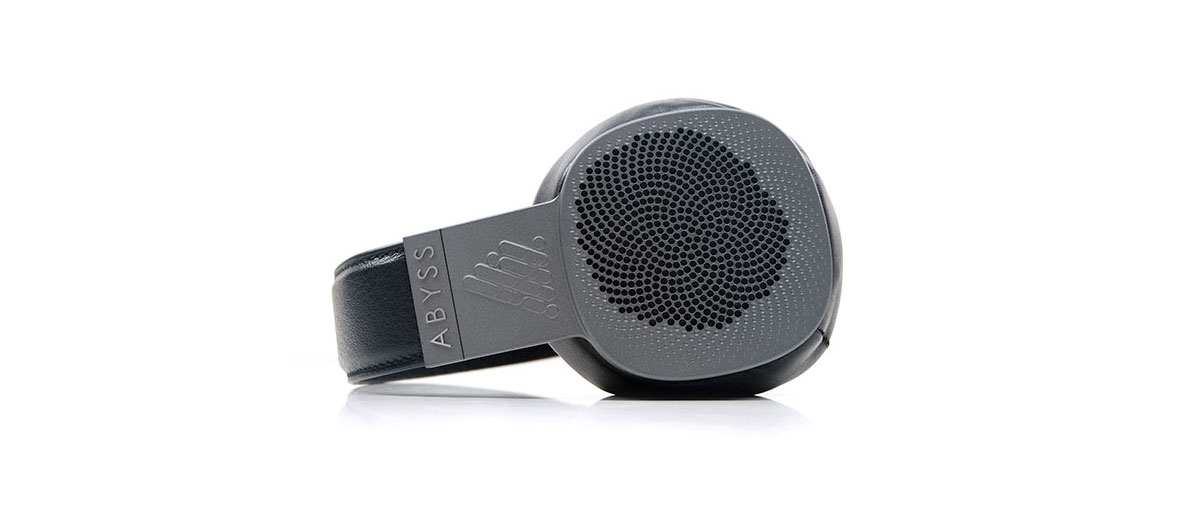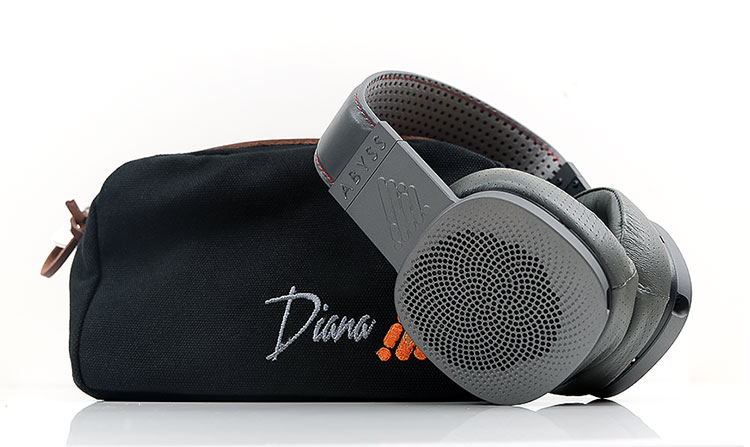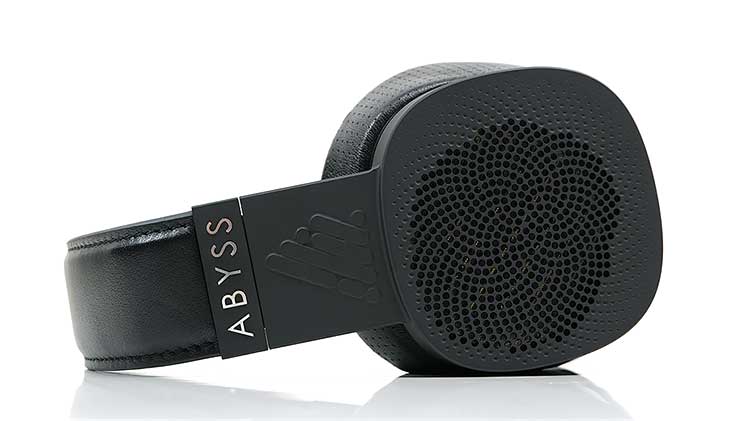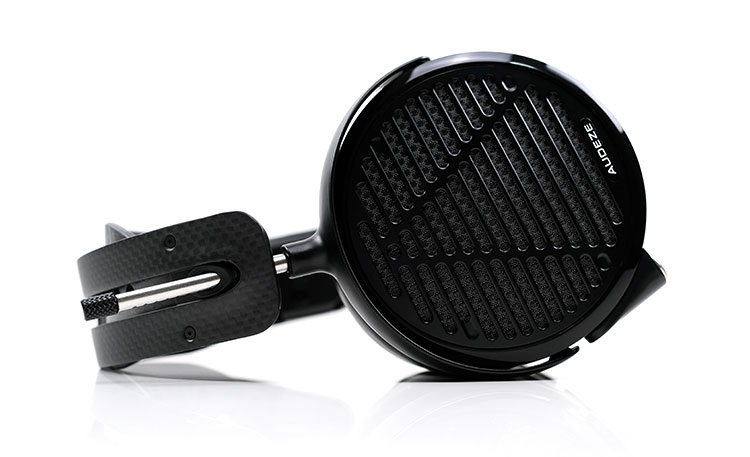Select Comparisons
All comparisons were completed with a mix of the dCS Lina DAC and headphone amplifier, a Holo Audio Spring 2 DAC, and the Feliks Audio Envy.
Abyss Headphones Diana Phi
$3995
The Diana Phi was originally reviewed by us back in 2019 and it was also one of our Top Gear Award winners for that year. It has now been discontinued by Abyss but there is still a healthy resale market for it.
Technical
Technically the Phi rather than the V2 is the predecessor to the Diana TC. Both headphones use that 63mm diameter size planar driver drawn from the AB-1266 Phi and thereafter the Phi TC version.
Both versions also use Abyss’s ultra-low mass diaphragm, however, the TC version has an improved trace design over the voice coil and a larger active surface area on the diaphragm where the company claims an enhanced level of resolution.
To accommodate that, the Diana TC has a more open acoustical environment with the physical honeycomb Fibonacci pattern on the cups now with wider holes for superior venting and air movement.
In terms of efficiency, there are some changes here with the older Phi slightly resistant at 32Ω compared to 69Ω and offering a slightly higher 91dB SPL compared to 90db SPL. In truth, both need a good amplifier to maximize their performance, even more so the Diana TC.
Design
The outward appearance of both Diana’s is very similar with the two headphones beautifully designed, compact, and very sturdy with few articulating parts. These are not rigid designs though since the ceramic aluminum frames have a high degree of flex and bend in them when required.
The differences are therefore subtle rather than overt and when I speak of differences you have to remember it’s based on the launch product offering not what Abyss was offering before they discontinued the Phi.
That primarily means the pads with this sample of the Phi using the smaller gen 1 versions with the reduced surface contact area and the slightly stiffer memory foam build.
The inner opening seems much the same but the new Diana TC pads are superior with the improved contact surface area and softer memory foam making the clamp steadier and decreasing the vertical pressure hot spots.
The other subtle design change is again comfort related with a little bit of a ribbed cushioning on the underside of the headband. It is not a night and day difference but an improvement on the original flat Phi headband nevertheless.
We already covered the Fibonacci patterning changes so in all other aspects the Phi and Diana TC physical appearance and stock cable options are unchanged.
Performance
A few differences for me between these two and mostly on the technical side with some imaging differences that leap out first.
The overall staging difference feels like a study between a well-padded studio room, (phi) and a mid-sized hall acoustical environment, (TC). The Diana Phi sounds the more intimate overall but that intimacy is driven by a 1-2k range that images a bit closer compared to the Diana TC which feels less mid-forward in comparison.
The Diana TC upwards mid-curve is more gradual with a bit more peaking higher up at around 3k for me and a very slight scoop just before the lower mids around 400-500Hz.
The instrumental body is marginally more neutral in quantity but better defined and more articulate sounding. Mids convey some superior separation from the low-end and vocals deliver more of an ethereal quality as a result.
You could argue that the Phi has the more robust vocal quality given its intimacy but surrounding instruments are not quite as well spaced out and lose a bit of focus as a result.
You can definitely pick up on the superior headroom from the tuning of the Diana TC which feels a lot roomier and more holographic sounding from that repositioned instrumental and vocal imaging.
On the low-end, the Phi might have some more warmth and a closer-sounding mid-bass punch but the Diana TC seems better tuned to pick out the precise definition of very low registering notes. Sub-200Hz bass notes twist an turn with a lot more character and finesse whereas comparatively, the Phi is more simplistic or two-dimensional in its ‘thuds’.
Abyss Headphones Diana V2
The Diana V2 was reviewed by us back in 2020 and like the Phi won an award in our Top Gear Awards for that year. It is still available to purchase on the Abyss Headphones Website.
$2995
Technical
Although released after the Diana Phi, the driver inside the V2 is based on the original Diana driver which, in turn, was drawn from the original AB-1266 larger driver.
The difference from the original Diana V1 driver is an optimized trace pattern to the magnetic field to improve its resolution. The rough guide is a half-step above the V1 and below the Phi in terms of performance. The V2 also uses a slightly thicker diaphragm compared to the Diana TC version.
Like all Diana drivers, it comes in a 63mm size though the active surface area is smaller than the Diana TC build and it also has a smaller honeycomb opening on the Fibonacci pattern on its cups suggesting a slightly more restrictive acoustical environment.
The driver efficiency is slightly better on the Diana V2, this probably being the easiest of the 3 Diana’s to get an acceptable tone on lower-powered devices. The V2 is rated at 42Ω compared to the Diana TC’s 69Ω and just 1dB higher for SPL at 91dB compared to 90dB.
Design
The V2 form factor is the exact same as the Diana TC, however, once again timing is sweet because our V2 sample uses the older Gen 2 pads so we can see what changes have been made.
Note, all the Diana V2’s currently for sale come with the same magnetic detachable gen 3 pads so this is more a look back in time than a current model review.
The older gen 2 pads are perforated as opposed to the gen 3 pads being non-perforated with more surface area for contact with your head compared to the gen 1 pads but much less compared to the newer pads. The foam is also more pliant than the gen 1 but not quite as supple as gen 3.
What the gen 3 pads do aside from a softer finish to mitigate clamping pressure is to also hold the headphones in a slightly higher position, at least for my head. That reduces scalp hotspots from any vertical pressure that was more prevalent on the V2.
The V2 we have here is also missing the ribbed finish on the underside of the headband but the newer releases now have that TC finish. Everything else apart from the color options is the same. I do like the V2 in black though and wish the Diana VC had that option also.
Performance
Of the two headphones, the Diana V2 is the warmer, slightly denser, and darker of the two. It pulls the staging a bit more forward particularly for vocals in the 1-3k range and a mid-bass to lower-mids that have a bit more elevation around 400-500Hz giving it a more intimate quality than even the Phi.
In doing so, it loses out to the Diana TC for staging extension on both ends. The TC is much the roomier and more precise of the two with better treble extension and presence around 7-8k as well as more nuanced bass performance.
The Diana V2’s low-end has more of a 50Hz bump to it adding some richness to the bass that also creeps a tiny bit into the lower mids. It is a smooth tone, not bloated in any way, and adds a little bit more substance to fundamentals.
However, the bass layering and the definition from the Diana TC equivalent are more complex and convincing. Of the two, the TC low-end is the more open-sounding and resolving allowing individual notes to shine through in more detail.
Notes have a slightly lighter timber quality to them on the Diana TC and for that matter, slightly less even harmonics or warmth compared to the V2. This is a less forgiving headphone but one that is much more accurate with a faster transient response in general.
I still greatly enjoy the Diana V2 because of the 3 it is easier to drive and slightly more forgiving. However, the dynamics, clarity, and more holographic staging complexity belong firmly to the Diana TC.
Audeze LCD-5
$4500
The Audeze LCD-5 was reviewed just a few months ago in late 2021 and scored very highly indeed. It has a price point that is quite close to the Diana TC also.
Technical
The LCD-5 is more like a break from the past whereas the Diana TC is an evolutionary product in step with the AB-1266 development process. Both are open-back planar headphones and both push lightweight designs as a big factor in their respective development.
That being said, the LCD-5 does use a larger driver at 90mm compared to the more compact 63mm variant inside the Diana TC. Both also use a single-sided magnet array with the LCD-5 using no less than 14 Neodymium N50 magnets in a single-sided Fluxor magnet arrangement.
Air management is more stylized on the LCD-5 with its Fazor waveguide management system whereas Abyss does not go into the same depth of detail for public consumption. Instead, Diana TC’s venting focus is on the wider Fibonacci-designed honeycomb holes on the cups.
Both boast very low mass and thin diaphragms though at 90mm I would suspect the active area on the LCD-5 is the bigger of the two.
One thing both drivers have in common is an optimized trace pattern over the previous product rollouts. In the case of the LCD-5, the varying width parallel traces were used to optimize voltage headroom and make the driver more consistent and easier to drive. In the case of the Diana TC, it was less about efficiency and more about improved resolution.
As a result, the LCD-5 is rated a bit lower for efficiency at just 14Ω and 100dB SPL whereas the Diana TC is harder to drive at 69Ω and 90dB SPL. Of the two, the Diana TC will need a stronger amp to sound optimal.
Design
Very different design approaches but given that larger 90mm diver, the Audeze is the bigger of the two but not by a huge amount. The weight is slightly greater also at 420g but that is something of a revelation for full-sized Audeze headphones given they were previously 600-700g.
The Diana TC’s smaller driver allows it to stay more compact as well as retain a more robust ceramic-coated titanium frame. In order to get the LCD-5 down in weight, Audeze uses a lighter polished acetate enclosure combined with magnesium rods and gimbals with a bolted-on mini-XLR connector.
I think it’s Audeze’s best design yet in all honesty and it does feel fairly robust but not quite as streamlined as the Diana TC form factor.
I do prefer the headband strap and arch system of the Audeze but the Diana TC 3rd gen pads are comfier. Ironically, Audeze switched to the lean surface contact-edged pads that Abyss tried in a slightly different format with the Phi gen 1 pads.
Combined with a strong clamp, the LCD-5 is just not as comfortable laterally, though comfier vertically so the hotspots are on the side of the head for me after long listening sessions whereas the Diana TC does not have the same effect.
Performance
Neither of these headphones has Susvara or HD800-sized staging qualities being more rounded and slightly more to the intimate side given their smaller cup sizing.
However, side by side, the Diana TC is a little more balanced in terms of FR shaping with less vocal forwardness in the 2-3k region and more treble extension creating a stronger perception of height.
To my ear, there is not a huge amount of depth difference as both have a fairly neutral bass performance in their stock format. The difference to me is the degree of forwardness which is slightly greater on the LCD-5 bringing the perception of a bit more impact closer to your position relative to the stage.
The LCD-5 also starts an upwards curve a little earlier into the lower mids whereas the TC sounds like it has a tiny dip in the same region just creating some enhanced bass to mids separation. It does not carry the same warmth into the lower mids which in turn gives the LCD-5 a slightly meatier sounding mids timbre.
Through the mids and highs, the Diana TC is lighter in body but does sound the more articulate with transients that flick in and out at a much quicker pace. The LCD-5 is a steadier pace with a bit more body in general and that big forward 3k region that brings vocals front and center.
Instruments around that region play a bit behind the vocal imaging on the LCD-5 whereas the Diana TC is more relaxed in this region allowing it to capitalize on its speed and creating a more open-sounding and complex midrange.
The LCD-5 treble is more relaxed creating a slightly softer more rounded tone in general. The TC treble has more energy and sparkle delivering a more odd-harmonic overtone. It’s a leaner note but one that gives some additional vibrancy to the upper mids and lower treble presence.
Our Verdict
It is hard to overstate just how good the Abyss Headphones Diana TC is for such a small and cute-looking planar headphone. It belies its diminutive form factor with a superlative and engrossing performance that takes the Phi pitch to the next level.
Pair this with a quality amplifier and for my preference, a natural-sounding DAC, and feed it some good power and you will get one of the paciest and resolving presentations out there.
Is it the biggest stager out there? No, it is not, physics plays a role here and the larger AB-1266 Phi TC is going to be your go-to if you want a vast arena-like presentation. But what it has it fills accurately and impressively. You will not miss one iota of detail with this headphone, not one.
Abyss Headphones Diana TC Specifications
- Weight 390 grams
- Impedance 69Ω nominal
- Sensitivity 90 dB/mW







